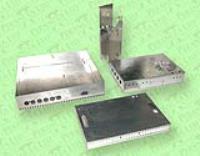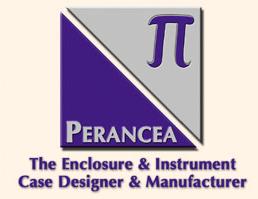 Add My Company
Add My Company
Sign In
Unravelling Electronics Packaging
08-12-2020

Unravelling Electronics Packaging
Compliance with the European EMC Directive is mandatory and that means keeping in and/or keeping out radio and magnetic frequency interference. What are the options and where do you start? From the grass roots perspective, what is available and what can be achieved at board level from a viable customised standard perspective?
The obvious is not always obvious when it comes to electronics packaging and especially circuit board mounted enclosures. Perancea has extolled the virtues of customised standard solutions that prove to be not only more effective in terms of doing their job in protecting whatever is inside the enclosure, from mechanical knocks and, most importantly, EMI/RFI.
EMI/RFI shielding is usually the driver for PCB mounted enclosure protection requirements. And on this score, Perancea has extensive sheet metal manufacturing facilities and the experience to boot, offering close tolerance sheet metal fabrication, as well as general tolerance enclosure solutions. The company has specifically geared up its manufacturing/products portfolio to producing a wide range of standard enclosures that are quickly, easily and cost effectively customised to the wide ranging requirements of electronics design.
EMC shielding is far more effective, simpler and more cost-effective at board level compared to assembly or even product level enclosures, where, for example, cable filtering and intricate designis required for anything that penetrates the enclosure shield. At board level, small shielding cans can be applied selectively to the problem areas of a circuit, directly tackling components with emissions that are too high or are too sensitive.
Simplistically, PCB shielding cans are metal boxes that are easily soldered in place just as any board level component. And with circuit board tracking and wiring shielded inside a can solution, the contained tracks and wires are very short and thus not efficient as antennae radiating RFI or EMI. Moreover, if filtering is required to further reduce emissions, it is usually minimal.
Although board level shielding using simple metal cans is much easier than shielding at enclosure level, there are still important design issues to be considered, there are also a whole host options that company’s like Perancea can incorporate to ensure you get the most effective shielding at viable cost.
On first impression, canned shielding on circuit board solutions gives more than a hint of special and custom design but the way Perancea operates its easily modified standards approach, it simply dispels any notion of high cost involvement. The company is geared up with an extensive range of precision CNC press tooling to cover most of the required features in providing a PCB mounted shielding solution. And there are no tooling charges! Its in-house tooling is easily adjusted to produce most required shielding variants.
For even drastically modified standards within the tooling scope, Perancea may only require the additional costs to be covered for software program changes to achieve the required solution which Managing Director Peter Hendrick maintains, would not normally exceed £45 although complicated designs requiring additional features may cost more. Most common hole sizes and cut outs such as D connectors are covered by existing tooling and, for example, on fingered can lids, specific fingers are easily omitted. The company can also easily accommodate out and out specials on quotation.
On the customised standard approach, Peter Hendrick points out that where quantities exceed 1000 pieces, there is a case for considering dedicated tooling. “Although this is chargeable, the cost is easily offset by a reduction in component cost,” he says. “This in turn would normally recover the cost of the tooling within a twelve month period.”
To contain EMI/RFI emissions, steel is an ideal and cost effective material for the application. For the Perancea shielding enclosures, the company is set up for a range of thicknesses, even below 0.5mm if required.
Copper and Brass, because of their conductivity, are ideal for screening in especially high frequency applications. But there is a cost penalty compared to steel, not just in the material cost but also because, like aluminium solutions, they cannot be spot welded and more expensive seam welding is required. Other material options include nickel silver which is more expensive and does not spot weld as well as ferrous materials, despite providing excellent screening and does not require plating.
For mechanical and cosmetic/aesthetic reasons rust and oxidation prevention is a must. On this score RoHS compliance is a must too, and available material processing needs careful consideration. Tin-plate or electro-tinned sheet are ideal plating processes for shielding applications. However, as plating takes place at raw material processing prior to fabrication, manufacturing processes, such as pressing and guillotining, and even bending and forming create exposed, bare steel edges which are obviously liable to oxidation in good conditions, let alone adverse operating conditions.
An important point to consider, says Peter Hendrick, is that because the plating is very thin, electrolytic tin plate cannot stand the rigours of ultrasonic cleaning which is often demanded in circuit board assembly processes. In essence, inherently weak spot welded joints, through the plating acting as a non-ferrous barrier to the weld, also leave unattractive surface marking. Nonetheless, for prototyping and other test sampling, electrolytic tin plate is cost-effective and an efficient solution.
Bright acid tinning, a solution sourced through the need in electronics manufacturing to take action with the environment in mind, and now policed and enforced by the RoHS Directive, is ideal for electronics EMI/RFI shielding solutions. Bright acid tinning cost-effectively delivers a good commercial grade finish for steel RFI/EMI shielding applications, with options on plating thickness of 10 microns nominal, 10 microns minimum and Def Stan 25microns, according to application. And as well as RoHS compliance, it is also solderable and virtually totally lead-free, with actual specification rated at less than 0.1% lead, mercury, cadmium, hex chromium or polybrominated diphenyl ethers.
The bonus of bright acid tinning is its inherent, uniformly bright finish with excellent solderability and fusing characteristics even after long periods of storage. “The finish is also an excellent conductor and provides protection against corrosion,” says Peter Hendrick, “with the deposited tin coating being ductile, bright and very attractive.”
Plating can also be provided to specific standards, with painting and anodising also available options but Perancea errs on the cautious as painted and anodised materials act as insulators although masking is feasible.
What makes the Perancea customised standard solutions to electronics packaging EMI/RFI shielding, according to Peter Hendrick, is the wide range of capability in its manufacturing that essentially keeps cost for low and medium volume production extremely viable and competitive. The range comprises lidded and non-lidded cans as well as shielding strips, which can also be lidded, that enable selective and more intricate shaped, localised PCB shielding. The capability also extends to fine tolerance and thin gauge materials and especially customised labyrinthine assemblies for circuit board sectoring.
Lidded enclosures simply provide access to the shielded components on the circuit board. Fingered lids provide maximum electrical continuity for EMI/RFI control whilst providing easy removal. Each finger gives a point of contact between the lid and the can or frame. The more fingers, the better the points of contact are and better the electrical path, with better screening properties. The company has devised its fingered lid designs to perform on EMI/RFI, as well as to give mechanical service and effectiveness. Although fingers can be removed according to customer requirements, finger profile is inherent in the design and not modifiable under the customised standard regime. Notably, says Peter Hendrick, “We recommend, however, that the frames and cans are thicker than the lids to give adequate resistance to the spring effect of the lid fingers.”
Four basic can styles form the basic range, together with SS screening strips for circuit board fences and dividers, from which Perancea evolves its extensive customised standard circuit board shielding solutions. “We produce five starter styles: four cans and the strips as standard,” says Peter Hendrick. PFLs come with circuit board mounting pins on one edge for mounting directly on to a PCB, and a removable fingered lid. FFLs are essentially frames with two lids for access to housed components from both sides.
Variations on those two include CFLs featuring butt jointed corners and a removable, fingered lid. Alternatively, for higher levels of screening, soldered corners are an option. For basic, low cost shielding, Printed circuit mounting cans are unlidded, with circuit board mounting pins on one edge for direct board mounting, with the option of soldered or welded corners.
“Virtually any size or shape can be made in all of the styles,” notes Peter Hendrick. “Importantly, there are no minimum quantity requirements for our ‘specials’ or for quantities above 100 in a single shipment. Our pricing structure is fully commensurate with those for a similar standard product.”
Invariably circuit boards are intricate and complex, demanding customisation to cater for PCB design features and assemblies. The basic five styles provide the means to achieving standard enclosure based solutions, with each style coming in a comprehensive range of lengths, width and heights, each specifiable according to external, internal or even centre of material thickness dimensions. For added features such as holes and apertures, dimensioning should preferably be according to centre lines.
Customisable features are legion within the Perancea capability. As well as corner overlaps, apertures, holes, cut-outs, slots and ventilation, the customised standard designs can easily incorporate: brackets; bushes, studs and stand-offs; mouse holes; PCB supports or guides, as well as lancing or brackets; lid captivation and retention, earth terminals; earth symbols; marking and component identification; fingering clearance; locking and/or tapered pins, and solder anti-migration barriers. “Generally these all come in within our concept of no tooling charges,” says Peter Hendrick, “and we also provide a fast turnaround service, as well as prototype quantities and even mechanical design services. And finished designs can also be engraved, screen printed, labelled, indelibly marked or stamped.”
Of those features, corner 5mm minimum overlaps on FFL and PFL styles reduce EMI/RFI leakage through the corners compared to simply formed cans, as a more cost-effective but less shielding effective solution than soldered or welded corners. Mouse holes in frames, cans and dividing strips can be easily produced to clear circuit board tracks and wiring whilst internal dividers, mechanically crimped tab and slot or spot welded in a can, provide effective additional shielding from high emission or to highly sensitive components.
Perancea designs can also incorporate PCB mounting pins, as well as locking pins to locate and retain the enclosure on the board. Lancing enables guidance and location for circuit boards and screening strips, and solder anti-migration barriers effectively prevent solder wicking via PCB mounting pins. Where lids need more positive retention, for example for security or where vibration can be a problem, these can be fixed by fold-over tabs, dimpling/hole location, screw fixing via threaded bushes and even corner lancing to take a screw through lid.
Perancea is a highly experienced mechanical engineering company specialising in the production of RFI/EMI shielding and other enclosures for the electronics and associated industries. The company, with its expertise, is also able to provide custom shielding and enclosure services to meet the needs of the broad range of application requirements from mechanical to electrical and electronics engineering applications.
For more information on Unravelling Electronics Packaging talk to Perancea Ltd
Enquire Now
List your company on FindTheNeedle.

